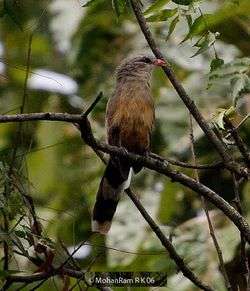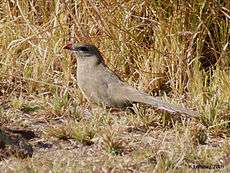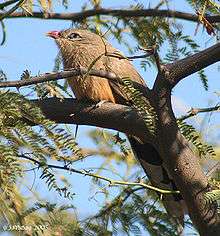Sirkeer malkoha
| Sirkeer malkoha | |
|---|---|
 | |
| Scientific classification | |
| Kingdom: | Animalia |
| Phylum: | Chordata |
| Class: | Aves |
| Order: | Cuculiformes |
| Family: | Cuculidae |
| Genus: | Phaenicophaeus |
| Species: | P. leschenaultii |
| Binomial name | |
| Phaenicophaeus leschenaultii (Lesson, 1830) | |
| Synonyms | |
|
Taccocua leschenaultii | |
The sirkeer malkoha or sirkeer cuckoo (Phaenicophaeus leschenaultii), is a member of the cuckoo order of birds, the Cuculiformes, which also includes the roadrunners, the anis, and the hoatzin. It is a resident bird in the Indian subcontinent.
Distribution
All of the sub-Himalayan Indian subcontinent, Bangladesh, Sri Lanka; patchy in Pakistan and Rajasthan. Sometimes considered as three races, varying in colouration.
Description
- Size: A largish bird at 42 cm.
- Appearance: Mainly earthy brown and rufous in colour, and the long heavy tail is edged with prominently white tipped graduated cross-rayed tail feathers. An obvious relation of the coucal (crow pheasant).[2] Bill is hooked, bright cherry-red and yellow. Sexes are similar, but juveniles are duller and barred above.
- Habitat: Largely terrestrial, open scrub and thorn jungle, deciduous secondary jungle. Singly or in pairs.
- Behaviour: Stalks about amongst thickets like crow-pheasant, searching for food; insects, lizards, fallen fruits and berries, etc. Runs swiftly through undergrowth looking like mongoose. Feeble flier, but ascends trees rapidly, hopping from branch to branch with great agility, like the coucal.
- Call: Normally a subdued "bzuk... bzuk" ; also an alarm call of "p'tang" with a metallic quality.[3]
- Food: A variety of insects, caterpillars and small vertebrates. It occasionally eats berries.[4]
Nesting
This cuckoo, like other malkohas, is non-parasitic.
- Season - March to August (varying with latitude)
- Nest: a shallow saucer of twigs lined with green leaves, in a thorn bush such as Euphorbia, or sapling 2 to 7 m up.
- Eggs: 2 or 3, white, with a chalky texture.
The scientific name of this bird commemorates the French botanist Jean Baptiste Leschenault de la Tour.
Gallery


 head shape
head shape at Hyderabad, India
at Hyderabad, India
References
- ↑ BirdLife International (2012). "Phaenicophaeus leschenaultii". IUCN Red List of Threatened Species. Version 2013.2. International Union for Conservation of Nature. Retrieved 26 November 2013.
- ↑ Ali, Salim; Sidney Dillon Ripley (2001) [1986]. Handbook of the Birds of India and Pakistan, 2nd ed.,10 vols (2nd ed.). New Delhi: Oxford University Press.Bird Number 598
- ↑ Ali, Salim; J C Daniel (1983). The book of Indian Birds, Twelfth Centenary edition. New Delhi: Bombay Natural History Society/Oxford University Press.
- ↑ Grimmett, Richard; Inskipp, Carol; Inskipp, Tim (1998). Guide to the Birds of Indian Subcontinent. London: Christopher Helm. ISBN 978-1-4081-2763-6.
This article is issued from Wikipedia - version of the 11/8/2016. The text is available under the Creative Commons Attribution/Share Alike but additional terms may apply for the media files.


